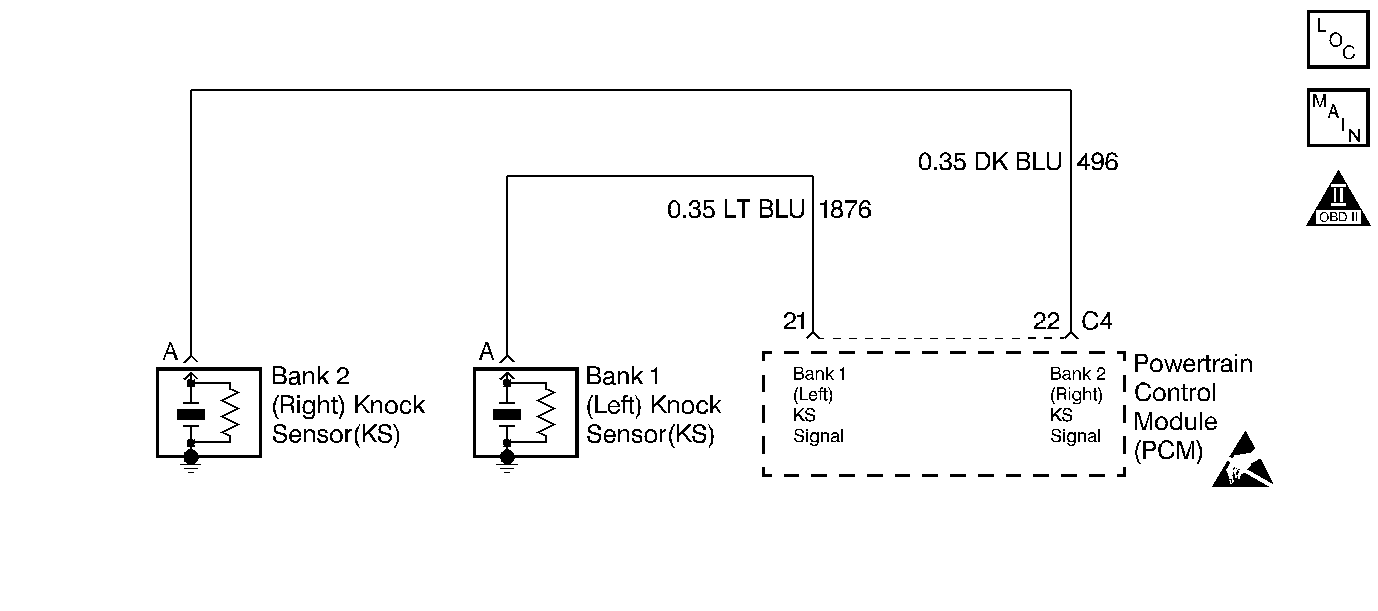
Circuit Description
The Knock Sensor (KS) system is used to detect engine detonation. The PCM will retard the spark timing based on the signals from the KS module. The Knock Sensors produce an AC voltage that is sent to the KS module. The amount of AC voltage produced is proportional to the amount of knock.
An operating engine produces a normal amount of engine mechanical vibration (Noise). The knock sensors will produce an AC voltage signal from this Noise. When an engine is operating, the PCM will learn the minimum and maximum frequency of the noise the engine produces. When the PCM determines that this frequency is less than or greater than the expected amount, a knock sensor DTC will set.
Conditions for Setting the DTC
| • | DTCs P0117, P0118, P0122, P0123, P0125, P1114, P1115 not set. |
| • | Engine operating time is greater than 20 seconds. |
| • | Engine Coolant temperature greater than 80°C (176°F). |
| • | Engine speed between 1100 and 2500 RPM. |
| • | Throttle angle greater than 10%. |
| • | The PCM determines that this frequency is less than or greater than the expected amount, a knock sensor DTC will set. |
Action Taken When the DTC Sets
| • | The DTC will be stored in the PCM memory when the diagnostic runs and fails. |
| • | The Malfunction Indicator Lamp (MIL) will not illuminate. |
| • | The PCM will record operating conditions at the time the diagnostic fails. This information will be stored in Failure Records. |
Conditions for Clearing the MIL/DTC
| • | A history DTC will clear after 40 consecutive warm-up cycles, if no failures are reported by this or any other non-emission related diagnostic. |
| • | A last test failed (Current DTC) will clear when the diagnostic runs and does not fail. |
| • | PCM battery voltage is interrupted. |
| • | Using a scan tool. |
Diagnostic Aids
Check the Knock Sensor for proper installation. A Knock Sensor that is loose or over torqued may cause DTC P0332 to set.
For intermittents, refer to Symptoms .
Test Description
Number(s) below refer to step numbers on the diagnostic table.
-
This verifies the malfunction is present.
-
Failure Records data does not include the parameter KS Activity, however other parameters may aid in locating the conditions under which an intermittent occurred.
-
This test will isolate the Knock Sensor from the rest of the circuit.
Step | Action | Value(s) | Yes | No | ||||||
|---|---|---|---|---|---|---|---|---|---|---|
1 | Was the Powertrain On-Board Diagnostic (OBD) System Check performed? | -- | ||||||||
|
Important: If an engine knock can be heard, repair the engine mechanical problem before proceeding with this diagnostic.
Does the scan tool indicate YES? | -- | |||||||||
Does the scan tool indicate that this diagnostic failed this ignition? | -- | Go to Diagnostic Aids | ||||||||
Does the DVM indicate voltage at the specified value? | 5.0 V | |||||||||
5 |
Is resistance of the knock sensor within the specified range? | 93K-107K ohms | ||||||||
6 |
Is any signal indicated on the DVM while tapping on the engine near the Knock Sensor? | -- | ||||||||
7 | Check the KS signal circuit for a poor terminal connection at the knock sensor. Was a problem found and corrected? | -- | ||||||||
8 |
Was a problem found and corrected? | -- | ||||||||
9 | Replace the Knock Sensor. Refer to Knock Sensor Replacement . Is the action complete? | -- | -- | |||||||
10 |
Was a problem found and corrected? | -- | ||||||||
11 |
Important:: Replacement PCM must be programmed. Refer to Powertrain Control Module Replacement/Programming . Replace the PCM. Is the action complete? | -- | -- | |||||||
12 |
Does the scan tool indicate that this test ran and passed? | -- | ||||||||
13 | Using the scan tool, select Capture Info, Review Info. Are any DTCs displayed that have not been diagnosed? | -- | Go to the applicable DTC table | System OK |
